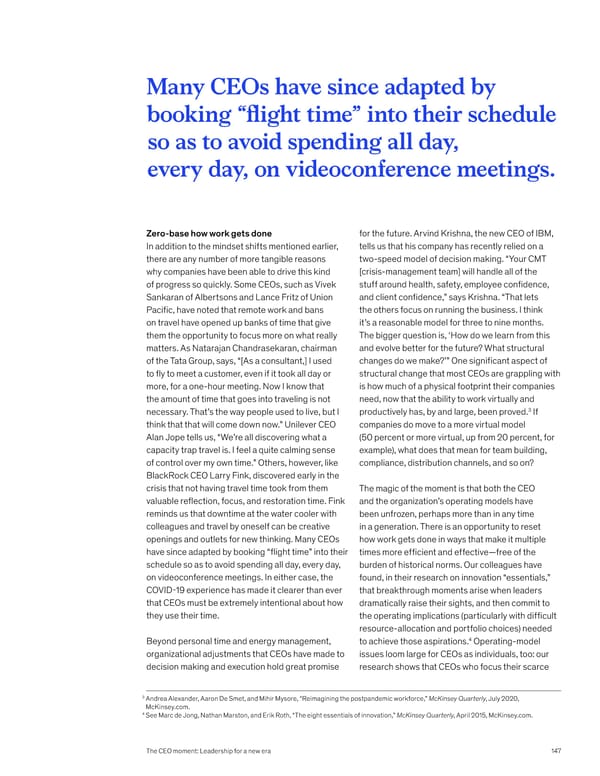Many CEOs have since adapted by booking “flight time” into their schedule so as to avoid spending all day, every day, on videoconference meetings. Zero-base how work gets done for the future. Arvind Krishna, the new CEO of IBM, In addition to the mindset shifts mentioned earlier, tells us that his company has recently relied on a there are any number of more tangible reasons two-speed model of decision making. “Your CMT why companies have been able to drive this kind [crisis-management team] will handle all of the of progress so quickly. Some CEOs, such as Vivek stuff around health, safety, employee confidence, Sankaran of Albertsons and Lance Fritz of Union and client confidence,” says Krishna. “That lets Pacific, have noted that remote work and bans the others focus on running the business. I think on travel have opened up banks of time that give it’s a reasonable model for three to nine months. them the opportunity to focus more on what really The bigger question is, ‘How do we learn from this matters. As Natarajan Chandrasekaran, chairman and evolve better for the future? What structural of the Tata Group, says, “[As a consultant,] I used changes do we make?’” One significant aspect of to fly to meet a customer, even if it took all day or structural change that most CEOs are grappling with more, for a one-hour meeting. Now I know that is how much of a physical footprint their companies the amount of time that goes into traveling is not need, now that the ability to work virtually and necessary. That’s the way people used to live, but I productively has, by and large, been proved.3 If think that that will come down now.” Unilever CEO companies do move to a more virtual model Alan Jope tells us, “We’re all discovering what a (50 percent or more virtual, up from 20 percent, for capacity trap travel is. I feel a quite calming sense example), what does that mean for team building, of control over my own time.” Others, however, like compliance, distribution channels, and so on? BlackRock CEO Larry Fink, discovered early in the crisis that not having travel time took from them The magic of the moment is that both the CEO valuable reflection, focus, and restoration time. Fink and the organization’s operating models have reminds us that downtime at the water cooler with been unfrozen, perhaps more than in any time colleagues and travel by oneself can be creative in a generation. There is an opportunity to reset openings and outlets for new thinking. Many CEOs how work gets done in ways that make it multiple have since adapted by booking “flight time” into their times more efficient and effective—free of the schedule so as to avoid spending all day, every day, burden of historical norms. Our colleagues have on videoconference meetings. In either case, the found, in their research on innovation “essentials,” COVID-19 experience has made it clearer than ever that breakthrough moments arise when leaders that CEOs must be extremely intentional about how dramatically raise their sights, and then commit to they use their time. the operating implications (particularly with difficult resource-allocation and portfolio choices) needed Beyond personal time and energy management, 4 to achieve those aspirations. Operating-model organizational adjustments that CEOs have made to issues loom large for CEOs as individuals, too: our decision making and execution hold great promise research shows that CEOs who focus their scarce 3 Andrea Alexander, Aaron De Smet, and Mihir Mysore, “Reimagining the postpandemic workforce,” McKinsey Quarterly, July 2020, McKinsey.com. 4 S ee Marc de Jong, Nathan Marston, and Erik Roth, “The eight essentials of innovation,” McKinsey Quarterly, April 2015, McKinsey.com. The CEO moment: Leadership for a new era 147
 What Now? Page 148 Page 150
What Now? Page 148 Page 150